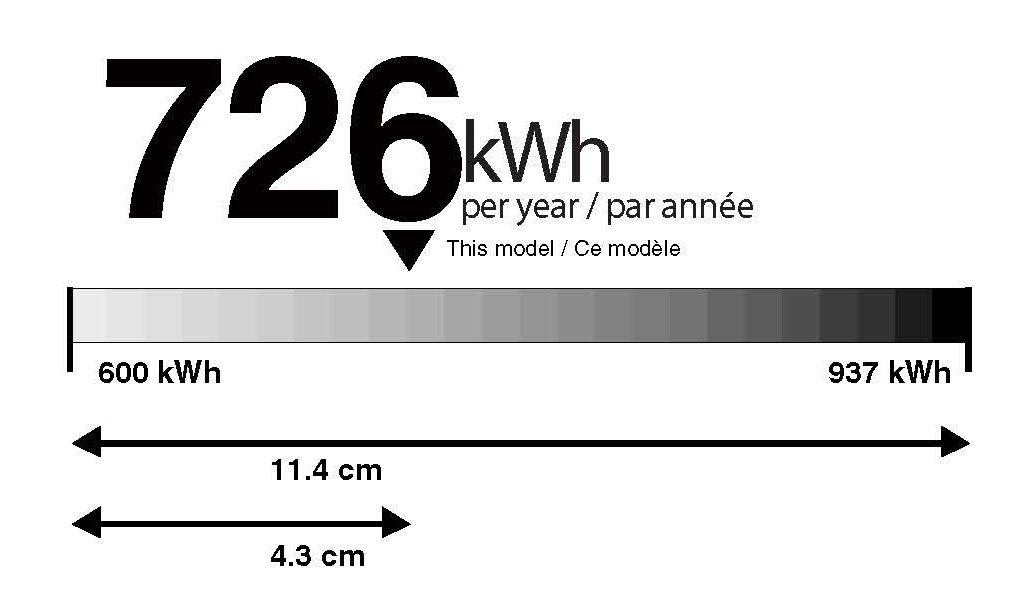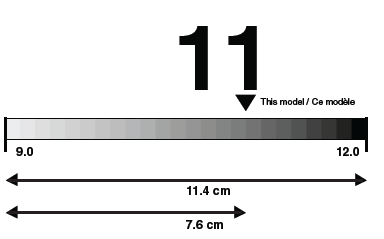EnerGuide label for appliances and room air conditioners
EnerGuide is the official mark of the Government of Canada for its energy performance rating and labeling program. The bilingual Canadian EnerGuide label is black and white.
The information provided by EnerGuide label allows consumers to compare different models. The data may be a rating number based on a standard measure or a verified average of energy consumption. It is not a certification mark.
Below you will find a compilation of frequently asked questions regarding the EnerGuide label. For questions about energy efficiency standards, prescribed test procedures, please contact Natural Resources Canada.
General questions
What products must have an EnerGuide label?
The following products are required to have an EnerGuide label:
- clothes dryers
- clothes washers
- dishwashers
- freezers
- electric ranges, cooktops and ovens
- integrated washer-dryers
- refrigerators, refrigerator-freezers and wine chillers
- room air conditioners
Are there EnerGuide labels for products other than appliances and room air conditioners?
The EnerGuide label is voluntary for:
- central air conditioners
- furnaces (oil-, gas- or propane-fired)
- heat pumps—air source
- gas fireplaces
- water heaters
There is also EnerGuide programs for:
Information for lamp package labelling requirements can be found on the Justice Laws website.
Consumer questions
I went shopping for a new appliance and I noticed some units didn’t have an EnerGuide label.
Not all EnerGuide labels will be in the form of a sticker on the front of the unit. EnerGuide label can also come in the form of a hangtag or a flap tag and in some cases can be displayed on the inside of the product.
How do I read the EnerGuide label?
The EnerGuide label is a valuable tool for consumers. It gives you key energy-related information about the product and allows you to compare the energy performance of a product among a range of similar models. Follow the link to learn more about reading the EnerGuide label.
What is the difference between the white and black EnerGuide label and the yellow and black Energyguide label?
You may see both the black-and-white Canadian EnerGuide label and the black-and-yellow American Energyguide label on new major appliances. The labels can be printed back-to-back on a hang tag or side-by-side.
Canada and the United States usually use similar test methods to determine the energy rating. However, the range on the scale may differ because of differences in the number and types of models available in each country.
Some EnerGuide labels also have the ENERGY STAR® mark. What does that mean?
Often products that are regulated and carry the EnerGuide label are also ENERGY STAR certified. ENERGY STAR certified products meet strict technical specifications for energy performance and typically are in the top 15 to 30 percent of their class for energy performance. In these cases, the ENERGY STAR symbol appears at the bottom of the EnerGuide label.
What is ENERGY STAR?
The ENERGY STAR symbol is the internationally recognized and trusted mark of high efficiency. The symbol means that a product is certified as energy efficient.
The ENERGY STAR name and the trademarks are registered in Canada by the United States Environmental Protection Agency and are administered and promoted by Natural Resources Canada.
ENERGY STAR Canada is a voluntary partnership between the Government of Canada and organizations in the public, private and not-for-profit sectors to promote energy efficiency.
ENERGY STAR certified products meet strict technical specifications for energy performance—tested and certified. They save energy without compromising performance in any way. More information on ENERGY STAR can be found at www.energystar.gc.ca.
Which products are eligible to be ENERGY STAR certified in Canada?
The ENERGY STAR program includes 75 product categories including the following:
- residential appliances
- commercial food service equipment
- electronics
- residential heating, cooling and ventilating equipment
- commercial boilers and light commercial air conditioners and heat pumps
- lighting products
- office equipment and data centres
- water heaters
- residential windows, doors and skylights
- lab grade refrigerators and freezers
- pool pumps
- water coolers
- electrical vehicle chargers
ENERGY STAR Canada’s full list of products.
How do products qualify for the ENERGY STAR mark?
To be ENERGY STAR certified, products must meet or exceed the energy efficiency criteria in ENERGY STAR technical specifications for each product and tested by approved certification bodies to be registered with the U.S. EPA or with NRCan. ENERGY STAR Canada shares the list of certified product models with U.S. ENERGY STAR.
How can my organization use the ENERGY STAR name and marks?
Only ENERGY STAR Canada Participants are able to use the ENERGY STAR name and marks in Canada. Join this voluntary program, it is easy, makes good business sense and is free! As a Participant, ENERGY STAR Canada gives you access to a first-class brand—tested, certified and backed by Natural Resources Canada.
Our Participants include organizations that are:
- a manufacturer, distributor or retailer of ENERGY STAR certified products
- a municipal, provincial, or territorial government department or agency
- a utility or energy efficiency program admnistrator
- a U.S. ENERGY STAR partner sells or manufactures products for sale in Canada
- an association or not-for-profit entity which promotes energy efficiency
- an enterprise that uses a large amount of energy in its buildings and operations, e.g., a national bank, major retail chain, hospital, university or college.
Dealer questions
How can I get templates and examples of EnerGuide labels?
Templates and sample EnerGuide labels can be downloaded from Natural Resources Canada’s website.
When are labelling scales updated?
The labelling scales are released annually in January for appliances and in March for room air conditioners.
What do I do if there isn’t a scale for my product?
Contact NRCan if a scale does not exist for your model. NRCan can create the new scale when it gets an energy efficiency report for the new model.
Do I need to get my labels approved by Natural Resources Canada before I put them on my product?
No. NRCan does not require you to submit EnerGuide labels for approval. However you may request that your labels be reviewed at any time.
Do I have to post copies of the EnerGuide label online?
No. NRCan does not presently have a requirement to post EnerGuide labels online.
How do I label my product if its annual energy consumption falls outside of the range?
When an energy efficiency report for a new model is submitted to NRCan after the annual release of the labelling scales and the energy consumption rating for that model is lower or higher than the range indicated on the scale, place the pointer outside the scale, i.e. to the right or to the left of the scale.
Where do I get the labeling scales?
EnerGuide labelling scales for appliances and room air conditioners can be downloaded from NRCan’s website.
Where do I place the arrow or pointer on the EnerGuide label?
In order to determine where the triangle on the EnerGuide label should be placed, use the following formulas to calculating the location:
APPLIANCES:
High kWh – Low kWh = X
Your Model’s AEC – Low kWh = Y
(Length of the scale ÷ X) x Y = Arrow location from the left end of the bar

Text version
Graphic of a sliding scale with 726 kilowatt hours per year above the scale along with a pointer indicating the position for this model. Directly under the scale are the numbers 600 kilowatt hours, on the left hand side, and 937 kilowatt hours, on the right-hand side. Below the scale is one arrow the length of the scale , with the number 11.4cm, and another shorter arrow indicating the length from the start of the scale to where the pointer should be positioned for this model at 4.3cm.
For example:
X = 937 – 600 = 337
Y = 726 – 600 = 126
(11.4 ÷ 337) x 126 = 4.3 cm from the left end of the bar scale
ROOM AIR CONDITIONERS:
High EER – Low CEER = X
Your Model’s CEER – Low CEER = Y
(Length of scale ÷ X) x Y = Arrow location from the left end of the bar

Text version
Graphic of a sliding scale with the number 11 above the scale along with a pointer indicating the position for this model. Directly under the scale are the numbers 9, on the left hand side, and 12, on the right-hand side. Below the scale is one arrow the length of the scale, with the number 11.4cm, and another shorter arrow indicating the length from the start of the scale to where the pointer should be positioned for this model at 7.6cm.
For example: X = 12 – 9 = 3
Y = 11 – 9 = 2
(11.4 ÷ 3) x 2 = 7.6 cm from the left end of the bar scale
Page details
- Date modified: